13 October 2014
For 25 Years Dance
Educators have Ignored the structural limitations of students and
refused to incorporate accentuated stretch programs. The
mentality, you either have it or you don't is the thought train at the
top, and that there is no way to improve a child's mechanical
ability. One master teacher from Russia went as far
as to say, that if we went by the rule book, the ballet classes would
be taught from 3rd position, not fifth, because 90 percent of the
students don't have the mechanical ability to work correctly from a
fifth position.
When
I teach accentuated classical ballet stretch and flexibility classes, I
demonstrate what I teach, and provide hope to all with the story about
how I developed all of my flexibility, after a started dance training
as a part of my sports development program for cross country skiing,
when I was in my early 20's. Following three years of intensive
training in modern, jazz and ballet, I was awarded a scholarship to
study the Soviet system of ballet training at the Nutmeg Ballet and
Conservatory for the Arts, in Torrington Connecticut. When I
arrived at the school, I had more hip flexibility or turnout, than 95
percent of the children in the program, many of which trained there
from pre-ballet. -- Regimen
Changes Body by Linda Boultinghouse by Permission of The Register
Citizen, Torrington, Connecticut. The type of training Apatow is providing will be "a major
thing of the future," Dante says. "We're going to somehow tie it into
our whole training program.
For
many years, the
importance of classical ballet specific flexibility
and
alignment training has been emphasized for dance education programs.
In classical ballet (the foundational training for all styles
of
dance), training is executed in a turned out
alignment,and requires specific stretches that must be integrated
into the pre-class warm-up. Unfortunately this guidance is many
times
ignored, at a cost of progressive
joint
stabilization and deformities in childhood development, that make
correct
postural alignment a virtual impossibility, and follow the student for
a lifetime. -- Centers
for Disease Control called to require proper stretch and flexibility
training before every classical ballet technique class: Sports
Medicine & Science Institute, 13 October 2014.
6 April 2009 - Updated
United Nations Arts Initiative
Arts Integration Into Education
Url: www.unarts.org
Twitter: unarts
Sports Medicine & Science Institute
Url: www.esportsmedicine.org
Email: info@esportsmedicine.org
Preventing Permanent Joint
Damage and Deformity in Classical Ballet Development
Guidelines
for Child Safety - Lower Extremity
As a parent, you need to understand the scope of training your child
participates in, with emphasis on safety and injury prevention.
Case 1.
Your child experiences an Achilles tendon or ankle injury in dance
class or rehearsal. As a precautionary measure, you seek guidance
from your physician for a diagnostic work-up.
First, does the physician check the alignment mechanics in the
foot/ankle/knee complex? If the answer is no, then the direct
mechanism of injury has been overlooked and there is no foundation for
true alignment stabilization, healing and future injury prevention.
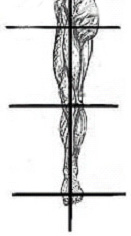
the classical ballet mechanical ideal:
heel behind centerline of foot, knee cap tracking over the center line
of ankle and foot. In the plie position (ABT Dictionary), the hip
complex and kneecap must track through this line. This alignment
is maintained through demi-pointe and pointe.
How to test lower extremity alignment:
Have
the child or student stands in parallel (heel behind centerline of the
foot), and then execute demi-plie. Drop a straight line from the
kneecap to the floor. Where does the kneecap track? If the
kneecap tracks through the centerline of the ankle foot, the alignment
is correct. If the kneecap tracks to the inside of the foot, then
the foot, ankle and knee complex is in a stressed internally rotated
alignment.
This internal rotation pattern represents the most common mechanism of
stress on the knee/ankle/foot complex with compensatory shifts that
translate to the pelvis and spine. This stressed alignment must
be corrected first in the parallel position, since if it cannot be
executed in parallel, it is impossible for execution in turnout.
Restoration of correct alignment, in parallel and turned out positions,
must be the objective of the physician, with guidance for the
therapist, teacher and parent regarding integration into all classroom
instruction.. If ignored, the symptomatic condition may be
alleviated via rest, but the vulnerability will remain. In
the context of surgery, if the alignment variable is not addressed,
then the mechanism of stress is not
addressed, resulting in an expensive procedure that could mark the end
of
a career.
Turnout: External Rotation of the foot
1. What is functional limitation of the student regarding turnout and
what are the consequences of forced turnout?
In the United States, the mechanical ideal in classical ballet
alignment and the mechanical ability to execute the demands of the
training is
a serious challenge. Instead of adapting a program and
concentrating on an intensive stretch and flexibility emphasis in
every class,
it is common to see students subject to the same demands as the 1 out
of
a1000 who would be selected in say an Eastern Bloc development program.
A common practice to function in denial, regarding the
functional limitations of the child, allowing the child's body to
gradually adjust to the stresses (which will happen when you start
training at a young age).
When we take young children, progressive loading of the joints
facilitates an adaptive strengthening and capacity to execute movements
with incorrect or stressed alignment. Despite the stressed
alignment, joint complex adaptation, bone development and
articular stabilization facilitates function in a non symptomatic
state. This holds true until an activity encompasses a load that
is beyond the ability of the malaligned joint complex to accommodate,
and an injury is sustained.
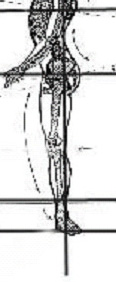
Joint deformation challenges from forced turnout, include
compensatory stabilization in articular development of the foot/ankle
complex, knee
complex, hip complex and spine.
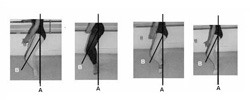 In teaching older developmental
levels of dancers during international summer programs, classical
ballet based biomechanics classes have revealed upwards of 90% of
students being unable to execute a parallel plie correctly. Many
of these students experienced joint discomfort when instructed how to
execute the correct alignment in parallel. In classical
ballet training, if we can't execute correct parallel plie, we can't
work correctly in a turned out position. In teaching older developmental
levels of dancers during international summer programs, classical
ballet based biomechanics classes have revealed upwards of 90% of
students being unable to execute a parallel plie correctly. Many
of these students experienced joint discomfort when instructed how to
execute the correct alignment in parallel. In classical
ballet training, if we can't execute correct parallel plie, we can't
work correctly in a turned out position.
When dancers and coaches from Eastern Bloc countries are asked about
these challenges, many will tell you that the vast majority of students
in classical ballet dance development programs do not posses the
mechanical
attributes required for the training. In a strict sense, they
should never be allowed to turnout beyond what their mechanical ability
allows. But this is an unpopular view that detracts from the
potential
number of participants in a program, so instead of emphasizing the
unpopular
alignment instruction, they adapt accordingly.
In gymnastics, the same holds true but from a slightly different
vantage point. In Eastern Bloc development programs, young
children (from a selection process) are placed in classical ballet
based choreography training, to develop fundamental movement mechanics,
6 days per week, 45 minutes
per day (in conjunction with the introduction of sports specific
movement).
But here in the United States, there is no time for the
fundamental
movement mechanics training. When the former gold medal Eastern
Bloc
coaches try to emphasize the importance of such training during U.S.
coaches
education programs, they experience great resistance. From a
business
standpoint, in order to enroll thousands of children in a program, the
sessions
per week must be limited in number and duration. In order to keep
their
prestigious national team coaches positions, the Eastern Bloc coaches
adapt
accordingly.
My focus when teaching USA Gymnastics Coaches development programs is
integration of classical ballet based alignment and biomechanics into
the sports specific movements. [1]
Analysis, Correction and Retraining for
Professional Dancers and International Ballet Competition
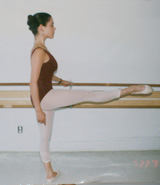
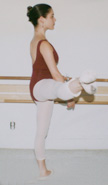 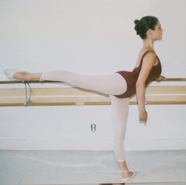 |
Biomechanical Analysis, Correction
and
Retraining consultation with Student Emily Patterson, Joffrey Ballet, IMDB,
The Company (2003), Save the Last Dance (2001). Parents: Dance Development Questions: Contact Susan Patterson:
President, Board of Directors, Nutmeg Conservatory for the Arts.
|
The development
of classical ballet based biomechanical analysis, correction and
retraining took place during the 80's and established international
acclaim in conjunction with Nutmeg Conservatory dancers training for
the Prix de Lausanne international ballet competition.
The focus of this work was to conduct a comparative alignment analysis
of the dancer, to the classical ballet based biomechanical ideal, as a
first step in correcting spine and extremity alignment developmental
problems
(stabilization in ankle complex, knee, hip complex, spine, etc.) that
resulted from 8-10 years of typical classical ballet training.
The next step
was to assess the potential for range of motion of the dancers spine
and
extremity mechanics, concentrated flexibility work, retraining in the
fundamentals
at the barre and choreography specific movement. This allowed the
dancer
to progress to the next technical level of development, previously
impossible
through the classical ballet development program alone. [2]
Additional information on this work is available on the International
Dancescience Development Program (eDancescience.org) [3]
web site:
Sports specific specialized applications
of this work include equestrian, football, baseball, soccer, hockey,
wrestling, martial arts, cross country and alpine skiing.
Classical Ballet Biomechanics and
Orthopedic Analysis Certification
The lack of educational resources has prompted the development of the
online:
Additional programs include:
- Educational/Development clinics:
An intensive program that includes detailed powerpoint
presentation of the CBBBOA1 materials, hands on participation in
analysis of alignment challenges, exam and certificate. This
program can be adapted for dance or sports specific applications. On
site programs also allow for integration of one on one classical ballet
based biomechanical analysis, correction and retraining sessions.
- Virtual consultancy for dance
and sports development programs. Email and telecommunications
combined with digital photos facilitates global access to classical
ballet based biomechanical analysis and guidance to assist performance
optimization and identification of articular alignment problems that
are associated
with the mechanism of joint injury. For additional information
visit
the International Dancescience Development web site. [3]
As an athlete, Stephen Michael Apatow [4] was fortunate enough to
acquire scholarships that allowed me to pursue my aspirations.
The pursuit of excellence and the Olympic Ideal [5] represents
the motivation for the development of our programs, and we will go out
of our way to provide support for all dancers, athletes and development
programs, during this difficult economic period.
References:
1. 1998 Gymnastics Coaches
Workshop: Choreography-Ballet Based Analysis, Correction &
Retraining
for Gymnastics Development Programs: Sports Medicine &
Science
Institute. Url: http://www.esportsmedicine.org/sportscience/gtcworkshop.html
2. Biomechanical Analysis, Correction
and Retraining: Reaching the Next Level of Performance
in Classical Ballet and Olympic Development Programs: Sports Medicine
&
Science Institute. Url: http://www.esportsmedicine.org/news/82005/805001.html
3. International Dancescience
Development Program: Url: www.edancescience.org
4. Stephen Michael Apatow: Founder, Humanitarian Resource Institute,
United Nations Arts Initiative, Sports Medicine & Science Institute
and International Dancescience Development Program: Url: www.apatow.org
5. Reaffirming the Olympic Ideal for the Purpose of Continuing the
Progress of Humanity: Humanitarian Resource Institute. Url: www.humanitarian.net/olympic_ideal.html
|